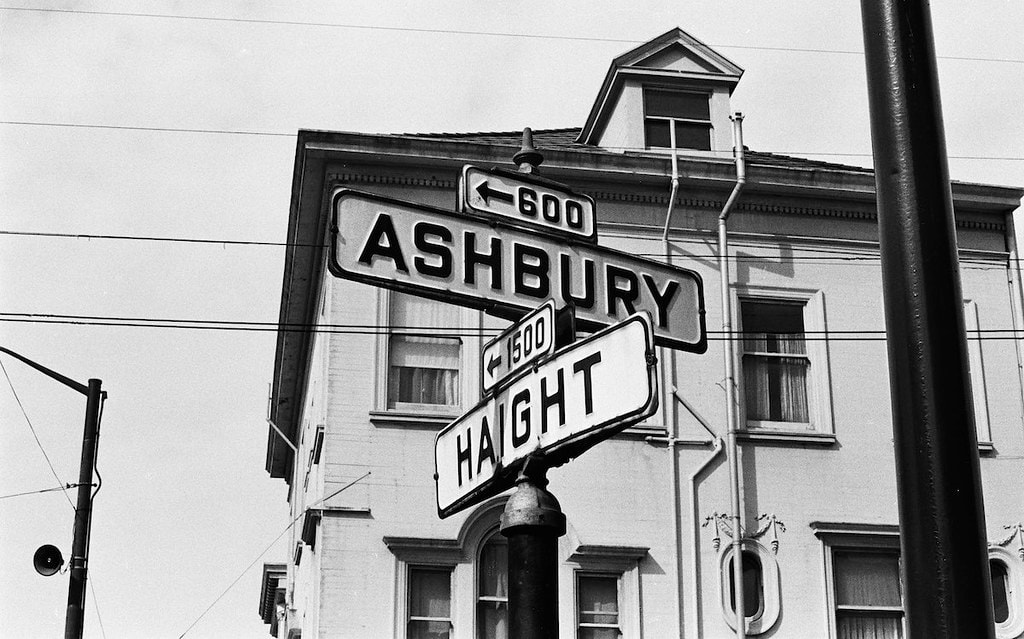Believe it or not, John Coltrane and Miles Davis inspired the hippie Summer of Love in 1967. Here's how.
JOHN COLTRANE
The lead guitarist of the Byrds folk rock group, Jim McGuinn (later known as Roger), transposed the short, choppy clusters of Indian classicist Ravi Shankar’s sitar sound to his 12-string Rickenbacker guitar and melded them to a phrase quoted directly from the intro to jazz tenor titan Coltrane’s 1961 composition “India.”
The result: the 1966 hit single “Eight Miles High,” which signposted a future for psychedelic music—variously labeled raga rock, acid rock, space rock—that would dominate American pop charts from 1967 to 1970.[1]
McGuinn was a fan of North Indian folk music, particularly that of Ravi Shankar, but so was John Coltrane. The latter’s interest, however, began several years earlier as he explored folk music from other countries, along with listening closely to the recordings of sitar virtuoso Shankar.[2]
Coltrane’s “India” was recorded at New York’s Village Vanguard in November 1961 and released on the Impressions album (Impulse!) in July 1963. This track, which also featured Eric Dolphy, was Coltrane’s attempt to incorporate everything he had recently learned from his folk studies.
The source of the melody line McGuinn borrowed for “Eight Miles High” was a Vedic chant (recitations from the Indian Vedas, religious scriptures dating back as far as 3,000 years) that Coltrane had heard on the 1952 Folkways LP Religious Music of India.[3]
So—from a 3,000-year-old Vedic chant to Coltrane’s tenor solo to McGuinn’s 12-string offering to God’s ears. How cool is that? Rock on!
Interestingly, “Eight Miles High” never climbed to the top of the charts during its release year, perhaps because it was too complex, too long, too fraught with controversy, and too tepidly promoted. But it had major influence on Laurel Canyon musicians Stephen Stills, David Crosby, Neil Young, and others during the 1967 Summer of Love.
The song has aged splendidly. In 1991, it was inducted into the Grammy Hall of Fame. In 2004, Rolling Stone magazine ranked it number 151 on its list of the 500 Greatest Songs of All Time, and in March 2005, Q magazine ranked it number 50 on its list of the 100 Greatest Guitar Tracks Ever.
MILES DAVIS
Just as “Eight Miles High” was based on a venerable religious sound by way of a prominent jazz instrumentalist, so too was “White Rabbit.” This 1967 counterculture anthem was based on a centuries-old Spanish religious processional song by way of trumpeter Miles Davis and orchestra arranger Gil Evans from their album Sketches of Spain. In this instance, the interpreting rock composer was Jefferson Airplane lead singer Grace Slick.
A year before she joined Airplane, Slick wrote “White Rabbit” at home on an upright piano at the end of an LSD trip during which she listened to Sketches of Spain and its “Saeta” track for 24 hours straight.[4]
“Saeta,” as described in the album’s liner notes, is:
One of the oldest religious types of music in Andalusa, [the“Saeta,” or “arrow of the song”] is usually sung without accompaniment during the Holy Week religious procession in Seville. It tells of the Passion of Christ and is usually addressed to the image of the crucified Christ that is carried in the march. . . . The singer is usually a woman, stands on a balcony overlooking the [stopped] procession . . . while the “Saeta” is being sung. A fanfare of trumpets gives the signal to move on.
Gil Evans has recreated the [music for] the street procession, and Miles has the role of the woman aiming the “arrow of the song.”[5]
She took her cleverly titled “White Rabbit” to her Great Society bandmates, and they quickly developed a six-minute version for their stage shows, replete with the Spanish march and echoes of Ravel’s crescendo-building bolero as implied in Sketches of Spain.
Grace soon left Great Society for Jefferson Airplane, taking her “White Rabbit” (and commanding siren voice) along with her, just in time for her new band to record a 2.7-minute version of the song on their second album, Surrealistic Pillow.
Released in January 1967, the album climbed the charts, reaching number three in August—not bad, considering the year’s dominating album was the Beatles’ Sgt. Pepper’s Lonely Hearts Club Band. The “White Rabbit” single was released in May. According to Rob Hughes of Classic Rock magazine, the song was meaningful to the time:
If one song came to define the Haight-Ashbury counter-culture itself, it was Airplane’s “White Rabbit.” Released in the loved-up summer of ’67, its heavy allusions to the altered states in Lewis Carroll’s Alice’s Adventures in Wonderland, along with its exhortations to “feed your head,” seemed to invite a whole new generation to trip out on the pleasures of psychedelics. For those for whom love, peace, and LSD were inseparable, it became an anthem.[6]
All of this makes for a fascinating juxtaposition, most would agree: Miles Davis as the “Saeta” singer in Sketches of Spain, and Grace Slick as the “White Rabbit” voice in Surrealistic Pillow.
CODA
For those interested in a transcription of Coltrane’s “India” improvisation from the Impressions album, please contact Coltrane expert Andrew White at Andrew’s Musical Enterprises Inc., 4830 S. Dakota Ave., NE, Washington, DC 20017. Ask for Coltrane transcription number 198.
- Rob Chapman, Psychedelia and Other Colors (London: Faber & Faber, 2015), 153.
- Lewis Porter, John Coltrane: His Life and Music (Ann Arbor, MI: The University of Michigan Press, 1998), 209.
- Ibid; Chapman, Psychedelia and Other Colors, 154.
- Rob Hughes, “The Story Behind the Song: White Rabbit by Jefferson Airplane,” Classic Rock, March 5, 2019.
- Liner Notes, Nat Hentoff, Miles Davis—Sketches of Spain, orchestra arranged and conducted by Gil Evans, Columbia Records, CD, CK 40578, 1960.
- Hughes, “Story Behind the Song.”
- Ibid.




 RSS Feed
RSS Feed